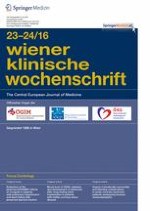Anzeige
01.12.2016 | original article
Changes in triglyceride, HDL-C, and non-HDL-C levels in patients with acute coronary syndrome
Erschienen in: Wiener klinische Wochenschrift | Ausgabe 23-24/2016
Einloggen, um Zugang zu erhaltenSummary
Background
Changes in high-density lipoprotein cholesterol (HDL-C) and triglyceride (TG) levels have been linked to residual cardiovascular risk, whereas non-HDL-C levels have been shown to be more predictive of cardiovascular risk than are low-density lipoprotein cholesterol (LDL-C) levels. We aimed to investigate the impact of HDL-C, TG, and non-HDL-C levels on acute coronary syndrome (ACS) risk with on-target LDL-C levels.
Methods
In all, 424 Caucasian patients aged over 50 years who had LDL-C levels below 3.4 mmol/l with a first or subsequent ACS event were enrolled in a multicenter, retrospective study. Lipid samples were collected within 4 days after the cardiovascular event. The subjects of the age-matched, gender-balanced control group (n = 443) had LDL-C levels below 3.4 mmol/l and were free of cardiovascular diseases.
Results
Patients with ACS had significantly higher TG and lower HDL-C levels compared with the control patients; however, we did not find any significant difference regarding non-HDL-C levels between the two groups. In regression analysis, the risk of coronary heart disease increased significantly with 1 standard deviation (SD) increase in TG and 1 SD decrease in HDL-C levels.
Conclusion
High TG and low HDL-C levels may contribute to residual cardiovascular risk in patients with well-controlled LDL-C levels; however, non-HDL-C levels at admission did not seem to be predictive for patients with ACS. Detection and treatment of secondary lipid targets such as high TG and low HDL-C levels may be important for the prevention of cardiovascular diseases.
